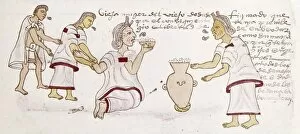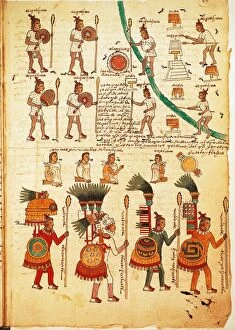Codex Mendoza Collection
The Codex Mendoza, a collection of hieroglyphic paintings from the Aztec civilization, offers a fascinating glimpse into the rich and complex world of ancient Mexico
All Professionally Made to Order for Quick Shipping
The Codex Mendoza, a collection of hieroglyphic paintings from the Aztec civilization, offers a fascinating glimpse into the rich and complex world of ancient Mexico. Dating back to 1540, this historical artifact provides valuable insights into various aspects of Aztec life. One illustration depicts Aztec warriors receiving trophies for capturing prisoners. It showcases their bravery and military prowess, highlighting the importance of warfare in their society. Another scene portrays a young Aztec man engrossed in patolli, a dice game that was popular among the people. This reveals their love for recreation and leisure activities. Intriguingly, the codex also sheds light on drinking customs among the Aztecs. Elders were allowed to indulge in alcohol to an extent that they could get drunk – a unique cultural practice indeed. However, it is important to note that excessive drunkenness was not tolerated by all; as depicted in one panel, capital punishment awaited those who crossed certain boundaries. Family dynamics are beautifully captured within these pages as well. A father teaching his son how to carry firewood and handle a canoe exemplifies intergenerational knowledge transfer and emphasizes practical skills essential for survival in their environment. Additionally, an image showcasing an Aztec wedding ceremony highlights the significance placed on marital unions within their culture. The it also features pictographs depicting Tenochtitlan (now Mexico City), providing us with invaluable information about urban planning during that time period. The fusion of Spanish text alongside these indigenous symbols demonstrates both cultural exchange and colonial influence. Lastly, moments of birth and baptism rituals are portrayed with great care and detail. From the birth of a child celebrated by family members calling out its name to grandmothers bathing newborns during baptism ceremonies - these scenes showcase cherished traditions surrounding new life within this ancient civilization.














